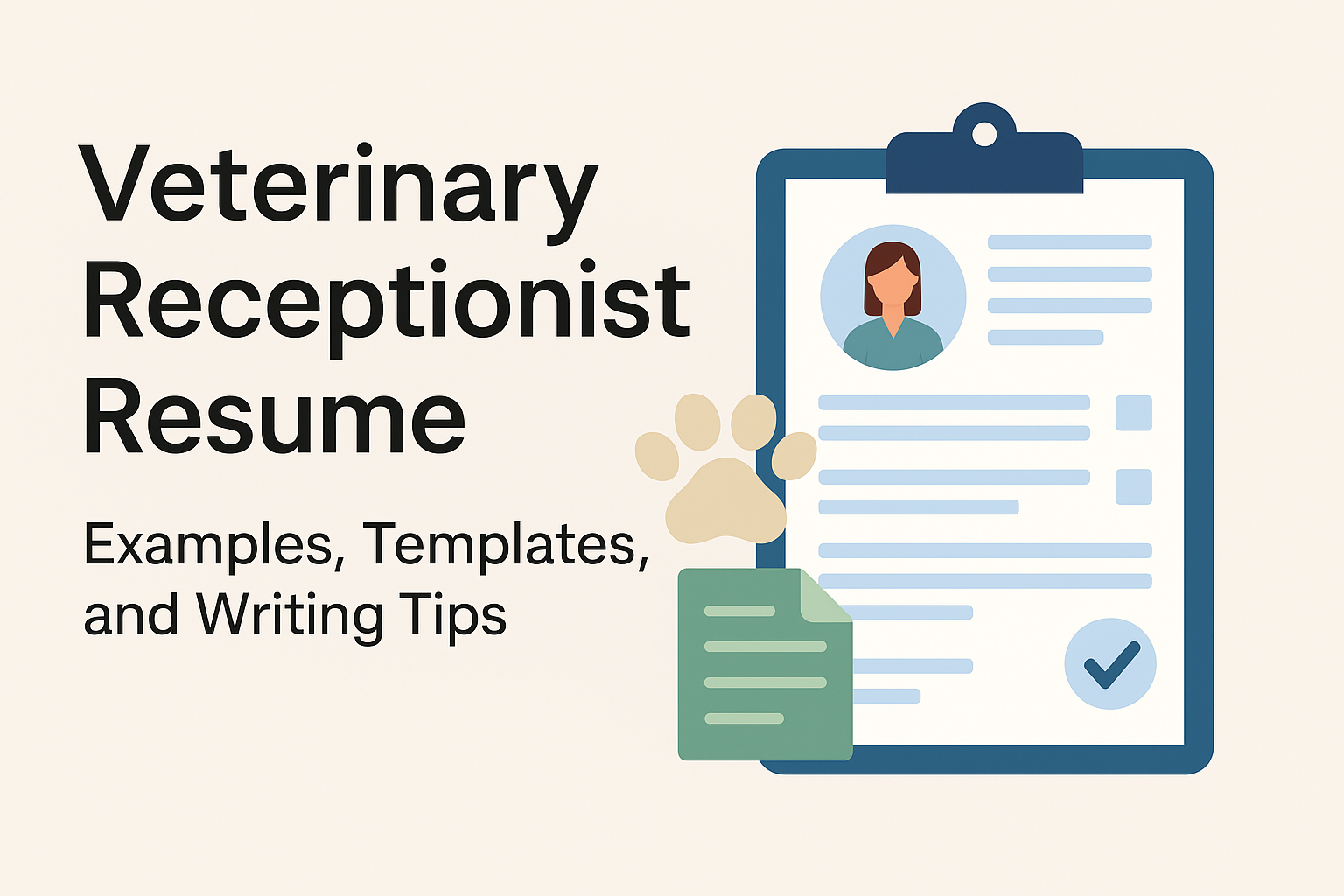In the highly specialized field of Anesthesiology, having a standout resume is essential for grabbing the attention of hiring managers. Our collection of resume examples for Anesthesiologist roles in 2025 showcases the best practices and critical skills that employers seek. Whether you’re a seasoned professional or new to the field, these tailored examples will empower you to present your qualifications effectively and confidently.
Anesthesiologist Resume Examples – Free Download
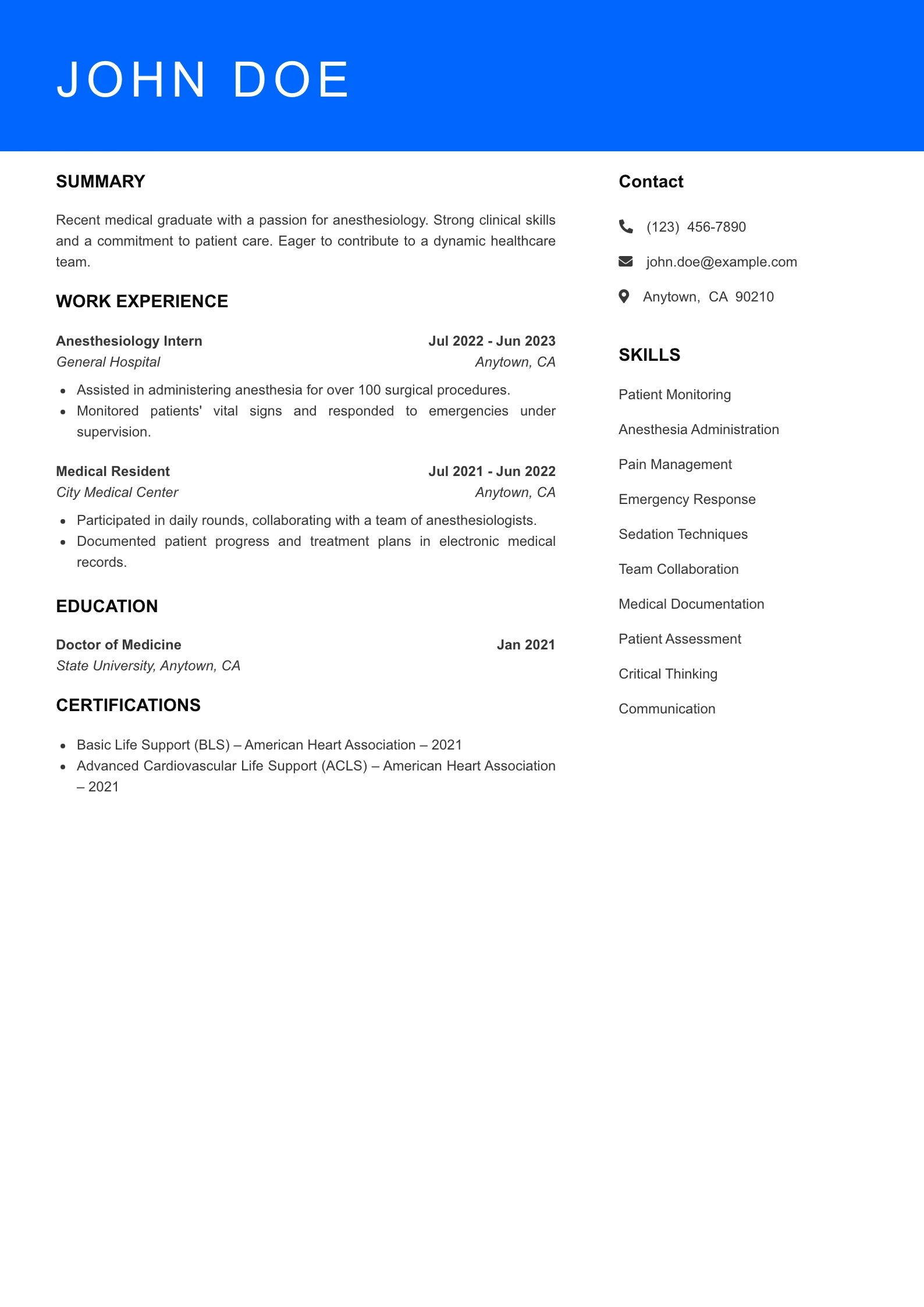

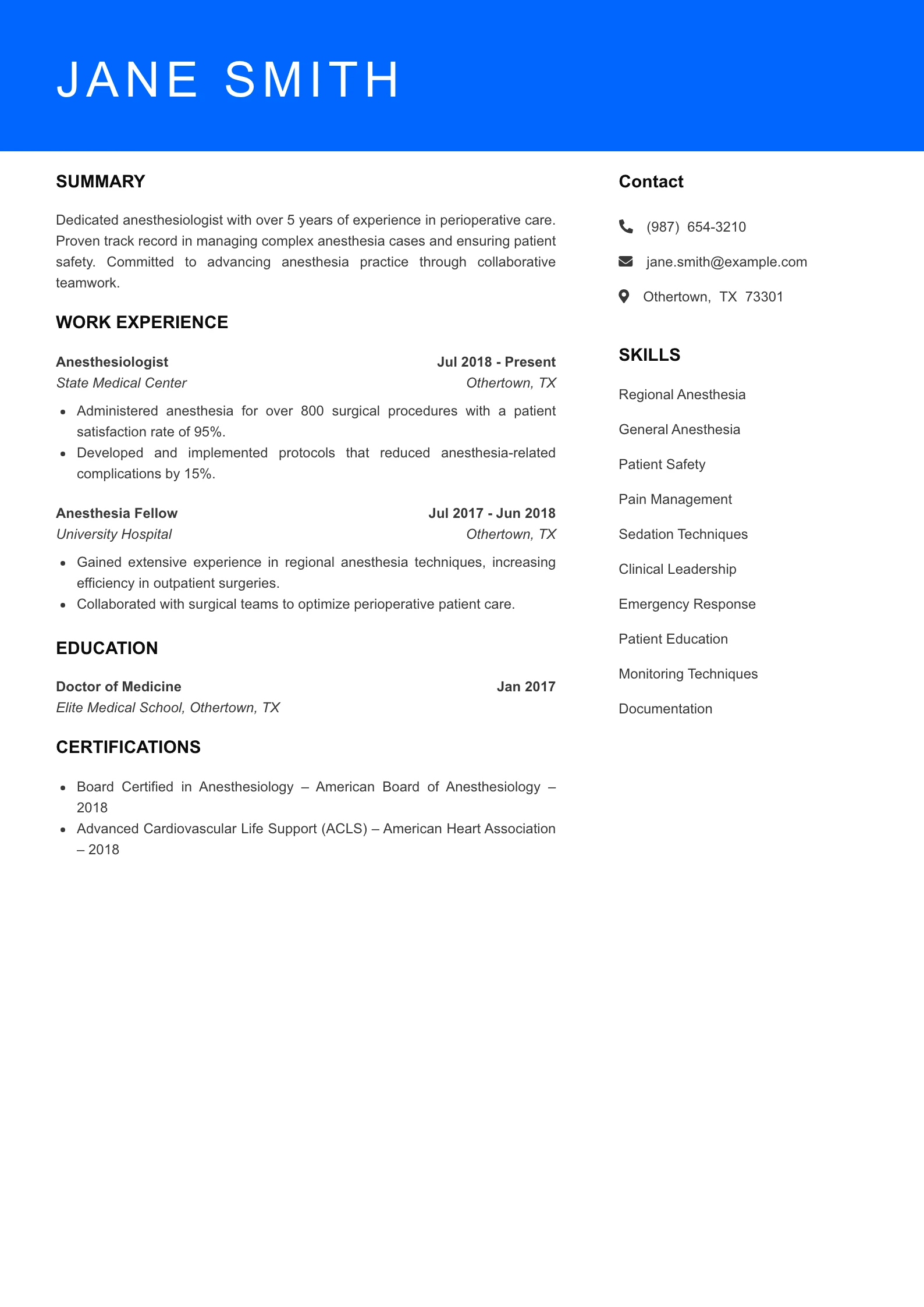
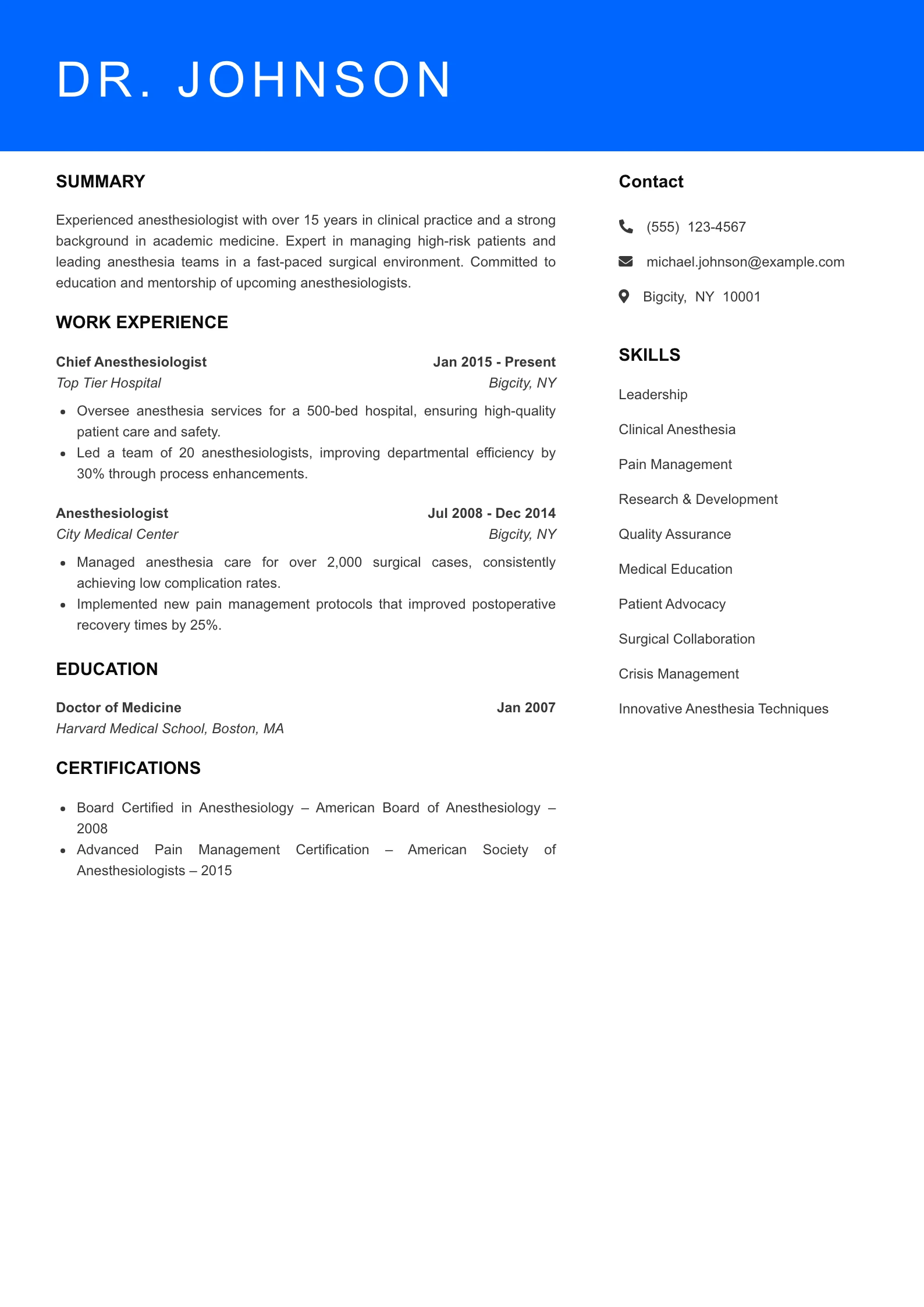
Anesthesiologist Resume Examples
Entry Level Anesthesiologist Resume Example

Why This Resume Works
- The summary is clear and concise, effectively highlighting John Doe’s qualifications and passion for anesthetic care, which sets a positive tone for the resume.
- Relevant skills are well-articulated, showcasing a mix of technical and soft skills essential for a career in anesthesiology, demonstrating readiness for the role.
- The work history includes impactful achievements, such as administering anesthesia for over 50 surgical procedures, illustrating practical experience and direct contributions to patient care.
- The resume reflects an entry-level position fit, with relevant internships and volunteer experiences that indicate a solid foundation in the field of anesthesiology.
- Clarity and tone are maintained throughout the resume, using professional language and structured formatting, which enhances readability and professionalism.
Mid Level Anesthesiologist Resume Example
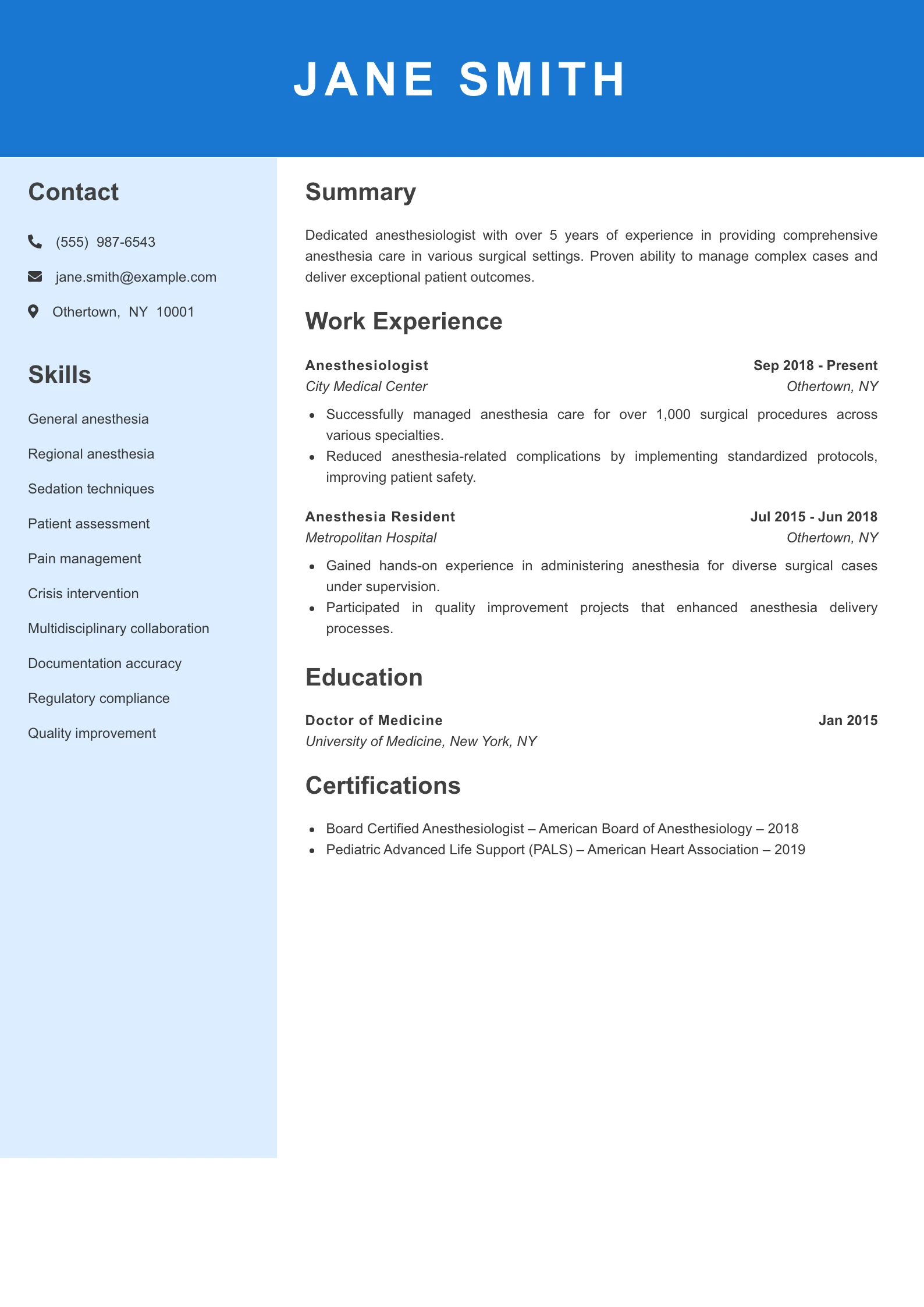
Why This Resume Works
- The summary is clear and concise, effectively highlighting Jane’s dedication and extensive experience in anesthesia care, which aligns with the expectations for a mid-level anesthesiologist.
- Relevant skills are well-articulated, showcasing a comprehensive range of anesthesia techniques and competencies that are critical for the role, enhancing her appeal to potential employers.
- The work history demonstrates impactful contributions, particularly in reducing complications and managing a significant volume of procedures, underscoring her effectiveness and ability to drive patient safety initiatives.
- The resume reflects a strong job fit for a mid-level position, given her five years of experience and progression from residency to a full anesthesiologist role, indicating her readiness for increased responsibilities.
- The overall clarity and professional tone of the resume contribute to a strong first impression, making it easy for hiring managers to assess her qualifications and suitability for the position.
Senior Level Anesthesiologist Resume Example
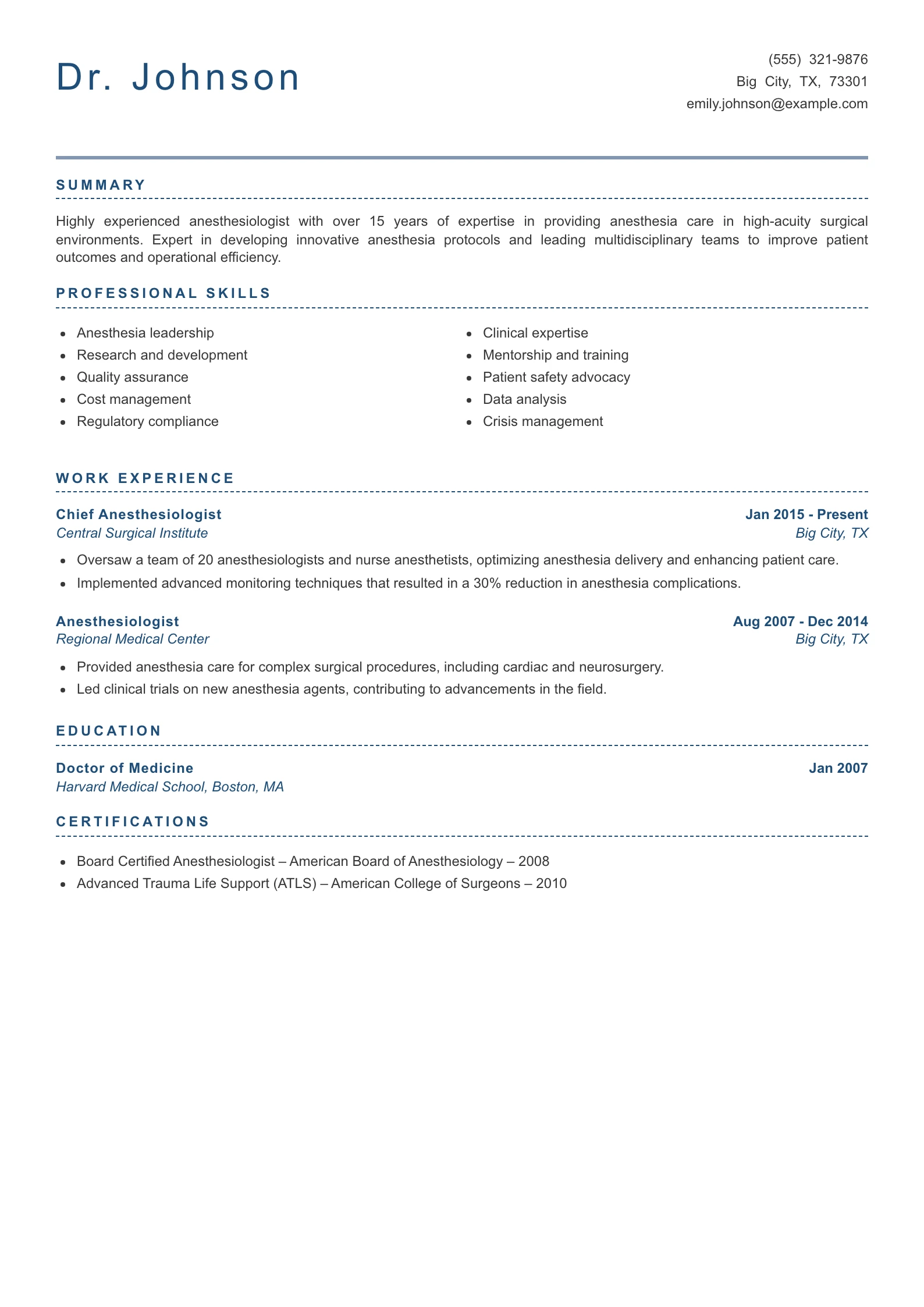
Why This Resume Works
- The summary is clear and effectively highlights Dr. Johnson’s extensive experience and key strengths, directly relevant to her role as a Chief Anesthesiologist, which aligns with senior-level expectations.
- The skills section is comprehensive and tailored, showcasing both clinical expertise and leadership capabilities that are critical for a management position in a high-stakes medical environment.
- The work history demonstrates impactful contributions, particularly through quantifiable achievements like the 30% reduction in anesthesia complications, illustrating Dr. Johnson’s effectiveness in improving patient outcomes and operational efficiency.
- The job fit is appropriate for a senior role, given her extensive experience and leadership responsibilities, which are well-reflected in her current position and past roles.
- The clarity and professional tone throughout the resume convey confidence and competence, making a strong case for Dr. Johnson’s qualifications and suitability for advanced positions in anesthesia leadership.
How to Craft a Strong Anesthesiologist Resume
A well-crafted resume is crucial for anesthesiologists, as it serves as your first introduction to potential employers. Hiring managers are typically looking for candidates who not only have the necessary medical qualifications but also demonstrate strong interpersonal skills and the ability to handle high-pressure situations. Follow this guide to effectively highlight your strengths and stand out in this competitive field.
Summary Statement
A strong summary statement is essential for anesthesiologists as it provides a snapshot of your professional identity. This section should succinctly showcase your experience level, any specializations, relevant soft skills, and certifications you may hold.
When crafting your summary, aim for a tone that is confident, tailored to the role, and focused on results. This is your opportunity to grab attention immediately, so ensure that it reflects your unique qualifications and career aspirations.
Compassionate and detail-oriented anesthesiologist with a solid foundation in clinical rotations and patient care, committed to providing safe and effective anesthesia during surgical procedures.
Mid-Level:
Dedicated anesthesiologist with over 7 years of experience in various surgical settings, specializing in pain management and regional anesthesia, known for exceptional patient outcomes and collaborative care.
Skills & Qualifications
Highlighting both core and soft skills is critical for anesthesiologists. Core skills might include anesthesia administration techniques, patient monitoring, and crisis management, while soft skills could encompass communication, teamwork, and empathy.
To determine the right skills to showcase, carefully review job descriptions and ATS requirements. Tailor your skills section to align with the qualifications that hiring managers prioritize, ensuring that your resume is not only compelling but also optimized for applicant tracking systems.
- Anesthesia administration
- Patient monitoring
- Crisis management
- Effective communication
- Team collaboration
- Pain management
- EHR proficiency
- Detail-oriented
Top ATS Keywords for Anesthesiologist
Work History
In the work history section, focus on showcasing your patient care experience, any relevant metrics, leadership roles, and specialized procedures you have performed. Ensure that your resume follows a reverse-chronological format, making it easy for employers to track your career progression.
Utilize quantified bullet points to demonstrate your impact in previous roles. Quantifying your achievements provides concrete evidence of your capabilities and can help set you apart from other candidates.
Resident Anesthesiologist, General Hospital, City, State, July 2022 – Present
– Provided anesthesia during over 200 surgical procedures, ensuring patient safety and comfort.
– Collaborated with a multidisciplinary team to develop patient care plans.
– Monitored patients’ vital signs and responded to changes in condition.
Mid-Level:
Anesthesiologist, Private Surgical Center, City, State, Jan 2018 – Present
– Administered anesthesia for a wide variety of surgical cases, achieving a 98% patient satisfaction rate.
– Led a team of five anesthesia providers, enhancing operational efficiency.
– Trained and mentored junior anesthesiologists and residents.
Education
An ideal educational background for anesthesiologists typically includes a Doctor of Medicine (MD) or Doctor of Osteopathic Medicine (DO) degree, complemented by residency training in anesthesiology.
Format your degrees and certifications clearly, listing the degree first, followed by the school name, city, state, and graduation year. This organized presentation helps hiring managers quickly assess your qualifications.
Degree, School Name, City, State, Graduation Year
Example:
MD, Harvard Medical School, Boston, MA, 2016
Additional Sections
Consider including optional sections such as Certifications, Languages, and Awards to further strengthen your resume. These sections can demonstrate your commitment to professional development and enhance your appeal to prospective employers.
For certifications, you might format them as follows: – Certification Name – Issuing Organization – Year – Example: Advanced Cardiac Life Support (ACLS) – American Heart Association – 2023
- Board Certified in Anesthesiology – American Board of Anesthesiology – 2018
- Advanced Cardiac Life Support (ACLS) – American Heart Association – 2022
Do’s and Don’ts
To maximize the effectiveness of your anesthesiologist resume, consider these practical tips:
Do:
- Tailor your resume for ATS by using relevant keywords.
- Show impact through quantifiable achievements.
- Use industry-specific terms to convey your expertise.
Don’t:
- Use generic statements that dilute your unique qualifications.
- Ignore the importance of showcasing soft skills.
- Overuse buzzwords that can make your resume feel less genuine.



